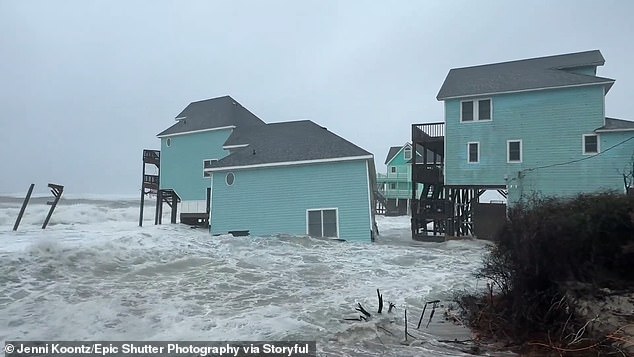The Atlantic Ocean is claiming more land and more homes along North Carolina’s fragile coast, as four more properties were swallowed this week in a devastating display of nature’s power.
What used to be a serene row of pastel vacation homes near Buxton on the Outer Banks is now a stretch of open sea — a haunting reminder of how fast the coastline is disappearing.
Waves Tear Through Vacant Vacation Homes
Between 10:45 a.m. and 1 p.m. on Tuesday, powerful waves ripped through a group of lifted turquoise homes that once overlooked the Atlantic.
Footage from the scene showed pieces of wood and debris floating away, with only the stilts left behind — eerie markers of where the homes once stood.
Thankfully, according to AccuWeather, all four properties were vacant at the time.
But that didn’t make the destruction any less shocking for locals who have watched the ocean inch closer to their doorsteps year after year.
A Coastline in Constant Retreat
The Outer Banks — a thin chain of barrier islands including Buxton and Hatteras — has long battled erosion and rising sea levels.
Since 2020, the ocean has consumed 26 homes on Hatteras Island alone, with two more demolished before nature could finish the job.
Experts say the problem isn’t new. From 1980 to 2020, the shoreline moved inland by roughly 675 feet — an average of more than 13 feet per year.
The islands’ narrow geography, combined with the lack of sea walls or protective barriers, makes them especially vulnerable to storms and shifting tides.
History Repeats Itself as Storms Grow Stronger
This isn’t the first time Buxton has faced such devastation. Earlier this year, five more homes collapsed within an hour as waves measuring six to twelve feet battered the coast.
Each property, worth around $400,000, had already been condemned since 2023 due to structural risks.
Even distant storms have left scars. When Hurricane Joaquin brushed past in 2015 — more than 500 miles offshore — the Outer Banks still sustained $2.3 million in damage from storm surge and powerful waves.
The Role of Climate Change in Coastal Erosion
Climate experts warn that the situation will only get worse.
Rising sea levels and increasingly intense storms, driven by climate change, are accelerating erosion and pushing the Atlantic dangerously close to coastal communities.
For residents and homeowners, each high tide now brings fresh anxiety about what could be lost next.
Highway 12: A Constant Battle with the Sea
Running through the length of the islands, Highway 12 has become both a lifeline and a symbol of struggle.
Constant flooding and washouts have made the road notoriously difficult to maintain.
Since 2012, repairs have cost the state more than $43 million — not including an additional $145 million spent to reroute parts of the highway farther inland.
For locals, the road’s closure during storms often leaves them cut off from supplies and emergency services, deepening the region’s vulnerability.
The Real Estate Ripple Effect
The environmental toll has also hit the housing market. Real estate sales across the Outer Banks dropped by 1 percent since last August, according to the Outer Banks Association of Realtors.
While condo sales have risen slightly by 5 percent, land sales have plummeted by 12 percent.
Property values remain high — with the median sales price creeping up less than 1 percent to around $633,000 — but uncertainty about future storms and erosion has cooled buyer enthusiasm.
Efforts to Clean Up and Protect What’s Left
In the aftermath of each collapse, the National Park Service has been leading cleanup efforts, removing debris from beaches and working closely with homeowners whose properties are at immediate risk.
To tackle the crisis more strategically, the Threatened Oceanfront Structures Interagency Work Group was established in August 2022.
The group brings together state and federal agencies to study the issue and develop proactive policies for managing homes in danger of collapse — before the ocean reaches them.
What’s Next for the Outer Banks?
The heartbreaking scenes in Buxton highlight a growing question: how long can the Outer Banks survive the Atlantic’s steady advance?
As climate change intensifies storms and raises sea levels, experts warn that communities along North Carolina’s coast may need to rethink how — or even where — they rebuild.
Share on Facebook «||» Share on Twitter «||» Share on Reddit «||» Share on LinkedIn
